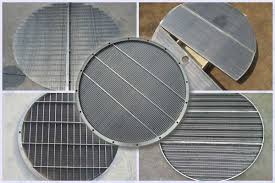The disc filters have
common applications in heavy duty processes for example dewatering of iron,
copper concentration, floats concentration and other industrial processes. The
filter discs were extensively used in 60s in the metallurgical plants.
The filter is made of
many discs about 15 in the large size equipments, each part consists of sectors
that are joined together to build the disc. The benefit is that disc filters
cover nominal floor space and cost per operation is much lower as compare to
vacuum filters.
Filter disc in
operation
During the operation,
every sector enters submergence and a cake is developed on the face of discs.
It then emerges to the drying region, the liquid drains to the middle barrel
from there via a valve to the vacuum receiver. The valve monitors the timing so
that as soon as sector exits the drying region, it goes over a separation
bridge and a snap or low pressure blow is applied to cake discharge. Scraper
blades on every disc side direct the cake to discharge chutes that are located
between adjacent discs and are sufficiently wide to prevent clogged by dropping
cake. An agitator positioned at the end of tank collect slurry in suspension
that in other metallurgical processes collects solids with high specific
gravity that are abrasive.
Other disc filter types
Disc filters can serve
as vacuum disc filters or pressurized disc filters. Due to differential
pressure application on both sides of Hastelloy mesh filter discs, the effective filter area is
significantly larger than drum filter for the same floor area.
Pressurized disc
filters:
a.
Pressurized
disc filter involves the application of lower pressure gas to the slurry side
b.
The
compressed gas develops the essential pressure differential for filtration
c.
The filter
is configured in an air-tight housing.
d.
Filtration
starts when the disc quits the slurry
e.
Internal
valves and piping channel the filtrate far from all discs and towards a
receiver.
f.
The filter
housing is created to comprise of a redistributed process gases. It can be
developed from different materials.
Vacuum Disc Filters
a.
Cake
development: An internal valve opens that allows vacuum creation inside the
filter screen. The cake develops on a part of the submerged drum
b.
Cake
drying: With the rotation out of slurry by the slurry, the drying process starts.
Vacuum is applied to develop a pressure differential essential to discard the
filtrate.
c.
Cake
Discharge: An internal valve locks the vacuum at this level. The discharge
processes can be a scraper belt, belt or roll. The compressed air is used to
eradicate the cake from the filter screen.
Precoat disc
filters
A Precoat disc filter
performs as vacuum disc or a pressurized disc filter.
Capillary Action
disc filters: These filters
are used to dewater mineral concentrates and pelletize the feed slurries. The porous disc replace the traditional
filter cloth. The capillary action draws liquid through pores and a small size
vacuum pump is needed that significantly lowers the energy consumption.

No comments:
Post a Comment